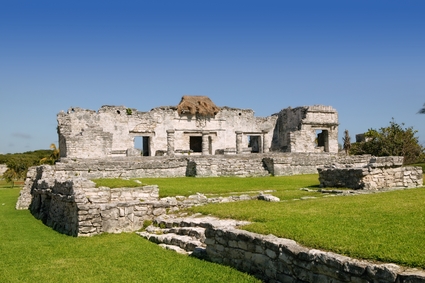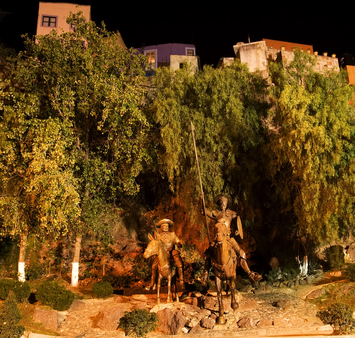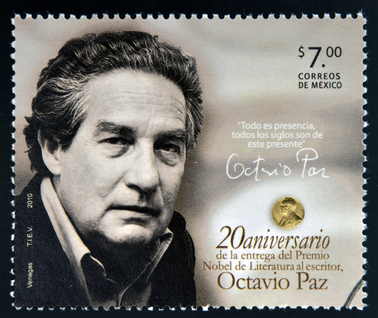History and Political Climate of Mexico
 The dramatic history and political upheaval of Mexico has always played a major role in the fluctuation of Mexican writers. The original literature of Mexico dates back to the indigenous settlements of Mesoamerica, but with the arrival of the Spanish many baroque writers couldn’t help but capture a more localized view on Mexican culture. As a result, many writings include a hybrid and mixed tone of these two cultures.
The dramatic history and political upheaval of Mexico has always played a major role in the fluctuation of Mexican writers. The original literature of Mexico dates back to the indigenous settlements of Mesoamerica, but with the arrival of the Spanish many baroque writers couldn’t help but capture a more localized view on Mexican culture. As a result, many writings include a hybrid and mixed tone of these two cultures.
Today we know that most of the pre-Columbian stories and folklore were mostly captured through verbal interpretations; however, Spanish priests helped preserve some of the writings of the Nahuatl speaking peoples by transcribing some of these works using the Latin alphabet. Due to this process, we now have some of these lyrical works preserved and passed down to us. This has given us access to works of people such as Acolmiztli Nezahualcoyotl who lived from 1402 to1472 as well as others from that time. To date, this translation is considered to be one of the largest samples of pre-Columbian works and philosophical lyrics that have been preserved for posterity.
As we move forward in time, the political instability in the nineteenth century led to further changes in all forms of art in Mexico and this included writing. Once more the Mexican Revolution changed the course of literature in Mexico as novels and plays of the civil conflict were written. This also led to such literary movements as “Estridentistas” and “Los Contemporáneos,” which were groups of individuals committed to the modernization of literature and Mexican culture in the first half of the 20th century.
Today, many writers in Mexico are considered to be the voice for society and are heavily relied upon to speak on social and economic issues which plague the country. As in many countries, these writers and journalists have continued to lead and comment on political occurrences; however, in recent years political arena analysts and economists have also begun taking on that role.
 There are many Mexican writers and journalists that have played an important role in the history of Mexico, and as such, their writings have greatly contributed to the shaping and remolding of various thought processes within the masses at probably every level. Some of these well known writers are those such as Alfonso Reyes Ochoa, Angeles Mastretta, Carlos Fuentes, Elena Garro, Elena Poniatowska, Guadalupe Teresa Amor Schmidtlein (Pita Amor), Homero Aridjis, Ignacio Padilla, Jorge Volpi, Jose Emilio Pacheco, Juan Rulfo, Laura Esquivel, Octavio Paz, Rosario Castellanos, and Salvador Elizondo just to name a few. Listed below is a brief synopsis of their overall contribution to the literary world.
There are many Mexican writers and journalists that have played an important role in the history of Mexico, and as such, their writings have greatly contributed to the shaping and remolding of various thought processes within the masses at probably every level. Some of these well known writers are those such as Alfonso Reyes Ochoa, Angeles Mastretta, Carlos Fuentes, Elena Garro, Elena Poniatowska, Guadalupe Teresa Amor Schmidtlein (Pita Amor), Homero Aridjis, Ignacio Padilla, Jorge Volpi, Jose Emilio Pacheco, Juan Rulfo, Laura Esquivel, Octavio Paz, Rosario Castellanos, and Salvador Elizondo just to name a few. Listed below is a brief synopsis of their overall contribution to the literary world.
Brief Bio of Mexican Authors
Alfonso Reyes Ochoa: He was born in Monterrey, Nuevo León on May 1889 and died on December 27, 1959. He was a philosopher and a writer and went on to become a diplomat (ambassador) and lawyer. His father was known to have held important positions during the reign of Porfirio Díaz which most likely shaped and molded his way of thinking. His education mostly took place in Mexico City and his first book was published at the age of 21; Cuestiones Estéticas. He also wrote a short story called La Cena (The Supper). Eventually he would move to Spain and this is where he wrote his best known literary work Visión de Anáhuac (1915).
Ángeles Mastretta: Is a journalist and Mexican author well known for writing on the social and political climate of Mexico using fictional and inspirational women characters. She has indicated that her father was the inspiration that put her on her journalist path. She went on to receive a scholarship from the Mexican Writers’ Center and was able to work with other well known authors such as the likes of Juan Rulfo and Salvador Elizondo. Later she published a poetry collection titled La Pájara Pinta (The Colorful Bird). Eventually she went on to publish a novel called Arráncame la Vida (Tear This Heart Out), which was an instant success. With this novel she won the Mazatlán Prize for Literature as the “Best Book of the Year.” In addition, she also published the novels Mal de Amores (Lovesick), and Mujeres de Ojos Grandes (Women with Big Eyes).
Carlos Fuentes: Born on November 11, 1928 to a Mexican diplomat, he wrote more than 30 novels and was a respected writer, diplomat, and critic. He passed away May 15, 2012. Almost all of his novels had a political overtone. Some of his works are Where the Air Is Clear, The Death of Artemio Cruz and The Most Transparent Region in the World. He was the first Mexican writer to have a novel turned into a Hollywood film (The Old Gringo) and upon his death he is known as the most internationally recognized and influential Mexican voice. During the latter part of his life, a “spar” between him and Octavio Paz occurred due to a difference of political opinions.
Elena Garro: She was a great Mexican writer and was once married to the famous Octavio Paz. She was born on December 12, 1920 and died on August 22, 1998. Her father was Spanish, but her mother was Mexican. Her childhood was spent in Mexico City but eventually she moved to Iguala Guerrero. Her studies included choreography, literature, and theatre. Octavio Paz and Elena had one daughter together; however, in 1959 they were divorced. It appears that Elena may not have known of the divorce due to the standing of her final will.
She is also known for accusing Mexican intellectuals of instigating students to riot, which led to the Tlatelolco Massacre. The resentment against her from the intellectual community took her to live in France for twenty years. Her literary works are known to carry themes of racism and the marginalization of women. A few of her literary works include Los Recuerdos del Porvenir (1963), Y Matarazo no Llamó (1991), a short story called La Culpa es de los Tlaxcaltecas, and a documentary drama titled Felipe Angeles.
Elena Poniatowska: She was born in 1932 to Polish and Mexican aristocrats. Through her career she has published fictional novels, non-fictional novels, and journalistic essays. During the 1960’s she conducted interviews and wrote stories on the social affairs in Mexico. Her novels which include La Noche de Tlatelolco and Lilus Kikus focus on human rights and the oppression of women and the poor. She is the only Mexican writer whose novels have been translated into German, Polish, English, French and Danish. She continues to occasionally write for the same newspaper, Excélsior, which started her writing career in 1953.

Guadalupe Teresa Amor Schmidtlein (Pita Amor): She was born on May 30, 1918 in Mexico City and died on May 8, 2000 (twenty two days short of her birthday). Her pen name was Pita Amor. She went on to become a poet and roamed the friendship circuits of Diego Rivera and María Félix. She would eventually come to be known as the “The 11th Muse.” As a model she posed nude, which shocked her Mexican Aristocratic lineage family. She is also known as being the aunt of Mexican author Elena Poniatowska. Some of her literary works are Yo Soy Mi Casa (1946), Poesía (1948), Polvo (1949), Todos los Siglos del Mundo (1959), and Soy Dueña del Universo (1984).
Homero Aridjis: Is a Mexican journalist, poet, novelist, diplomat, and is also known as an environmental activist. He was born in Contepec, which is located in Michoacán, Mexico. He was born on April 6, 1940. He is also the youngest of five brothers. His father is of Greek ancestry and his mother is of Mexican Descent. At the age of nine he survived a shotgun accident, which most likely contributed to him becoming a prolific reader. This is when he also began to dabble with poetry. He went on to receive a scholarship at the Centro Mexicano de Escritores supported by the Rockerfeller Foundation. Thus far, he has published at least 41 books comprised of prose and poetry and has won many distinguishable awards. His life journey has taken him to serve as Mexico’s ambassador to the Netherlands and Switzerland as well as to UNESCO in Paris. In addition, he held the title of President for the worldwide association of writer’s called International PEN.
Ignacio Padilla was born in Mexico City in 1968. He is a well known novelist and short story author. He is also known as one of the founders of the “Crack Movement” alongside Jorge Volpi, Eloy Urroz, and Pedro Angel Palou. Jorge Volpi: He was born on July 10, 1968 in Mexico City. His studies were focused on law and literature and went on to become a lawyer. He also received a PhD from the University of Salamanca, Spain, in Spanish philology (study of texts). The interest of these authors is to help authors find their own voice and incorporate that into their literary writings.
Jorge Volpi is well known as novelist. One of his best works is En Busca de Klingsor (In Search of Klingsor, 1999). This story takes place during World War II. It is about a mission of two people to discover information about the Nazi party’s scientific research methods. He currently teaches literature at UDLA, Puebla, Mexico. J
Jose Emilio Pacheco was born on June 30, 1939 in Mexico City. He is a well known poet and novelist. His gift of writing also includes short stories. He has been praised by the Berlin International Literature Festival as “one of the most significant contemporary Latin American poets.” His teaching resume includes such prestige institutions such as UNAM, University of Essex, and the University of Maryland. Some of his literary works include Los Elementos de la Noche, El Reposo del Fuego, No me Preguntes cómo Pasa el Tiempo (Poems 1964-1968), Islas a la Deriva, Album de Zoología, El Viento Distante y Otros Relatos (1963), La Sangre de Medusa (1977), and Las Batallas en el Desierto (1981).

Juan Rulfo was a Mexican writer born in Jalisco on May 16, 1917 and died on January 1986. He was also a screenwriter and a well known photographer. Two of his best works are Pedro Páramo (1955) and El Llano en Llamas (1953). The first is a novel and the second publication is a collection of short stories which most have been translated into English. Some of his photography work resides at the Juan Rulfo foundation.
His father was killed in 1923 and his mother died four years later in 1927 from cardiac arrest. Rulfo was then raised by his grandmother in San Gabriel, Jalisco. He studied at the Luis Silva School and earned his accreditation as a bookkeeper; although, he never worked in that profession. He then attended seminary school (secondary school) and thereafter joined the National Military Academy. Shortly after, he began to write under the watchful eyes of Efrén Hernández.
On August 12, 1928 he married Clara Angelina Aparicio Reyes. They had four children. Eventually he obtained a fellowship supported by the Rockerfeller Foundation (Centro Mexican de Escritores). This is where he wrote his two famous books. To date his book Pedro Páramo has been translated into many different languages.
Laura Esquivel was born on September 30, 1950. She is the third of four children. She is most notably known for the novel Como Agua para Chocolate (Like Water for Chocolate) which was released in 1989. This novel depicts the importance of food and the kitchen and how it relates to her life. It became a number one best seller in Mexico for three years and has been translated into several languages. This later went on to become a film and she earned the Mexican Academy of Motion Pictures award for this film. She also wrote a second novel The law of Love (1966), which combines science fiction and romance and takes place in the 23rd century. Her recent novel Malinche (2006) is centered on a near mythical figure of Mexican history. This story depicts the tale of the interpreter and mistress of the Spanish conquistador Hernan Cortez.
Laura Esquivel was previously married to director and actor Alfonso Arau. Currently, she is an official candidate for the PRD (Party of the Democratic Revolution).
Octavio Paz was born on March 31, 1914 and died on April 19, 1998. He was a great Mexican writer, poet and diplomat. His father was Octavio Paz Solórzano and his mother was Josefina Lozano. His father was against the Díaz regime and this was well known. He was brought up mostly by his mother, his aunt Amalia Paz, and his paternal grandfather Ireneo Paz who became a great influence in his life. His grandfather was a liberal, a novelist, and a great intellectual; this helped to mold and shape Octavio Paz’ thinking. The family supported Emiliano Zapata’s fight and this caused the family into exile to the United States.
 Because of his grandfather’s great literature background, Paz was introduced to great literary works. This no doubt caused him to publish some literary works at a very young age. His first collection of poems, Luna Silvestre (Wild Moon) was published at the age of 19. He then went on to found the literary review Barandal. He later left his law studies and went to work at a school in the Yucatán. He went on to write more poetry such as Entre la Piedra y la Flor (Between the Stone and the Flower). This poem depicted the treatment of Mexican peasants under the insatiable landlords of that time.
Because of his grandfather’s great literature background, Paz was introduced to great literary works. This no doubt caused him to publish some literary works at a very young age. His first collection of poems, Luna Silvestre (Wild Moon) was published at the age of 19. He then went on to found the literary review Barandal. He later left his law studies and went to work at a school in the Yucatán. He went on to write more poetry such as Entre la Piedra y la Flor (Between the Stone and the Flower). This poem depicted the treatment of Mexican peasants under the insatiable landlords of that time.
Later on in life, he also co-founded Taller, a literary journal and continued writing for this magazine till 1941. He then married the author Elena Garro and together they had one daughter. Eventually they were divorced. During that time, however, he began studying at the University of California at Berkeley, United States, and later became a diplomat for the Mexican government.
He went on to write, El Laberinto de la Soledad or The Labyrinth of Solitude, which was a study on the Mexican culture. He is also know for the great poem Piedra de sol (Sunstone) written in 1957 and Libertad Bajo Palabra (Liberty under Oath), which was a collection of his poetry up to that time. Thereafter, he moved to Paris to follow his lover the Italian painter Bona Tibertelli de Pisis. In 1962, he was named Mexico’s ambassador to India.
Most of his works have been translated into many languages throughout the world. Most notably, and right before his death in 1998, Octavio Paz became the first Mexican writer to ever win the Nobel Peace Prize for Literature.
Rosario Castellanos was a born in Mexico City on May 25, 1925. She passed away on August 7, 1974 from an ill-fated electrical accident. In the last century, she is known as one of the most significant literary voices. Her writing carried cultural and gender oppression themes helping to influence those arenas. She was and continues to be an inspiration to women writers and helped to open doors for them in the Mexican literature field.
As a young child she was an introvert and seemed to be aware of the troubles that pervaded the indigenous Maya working for her family. By her own accounts, she became estranged from her family due to a fortune teller’s prediction. It appears that the fortune teller predicted one of her mother’s children would die and her mother quickly came back with “not the boy!” This incident most probably helped shape and mold her family role and importance.
A land reform occurred which changed the family land holdings and also caused the family to Move back to Mexico City. A year later, her parents died and she was left alone at sixteen. She still remained an introvert; however, she became involved with intellectual groups. She attended UNAM, and later taught at the University. She also went on to hold several government posts and was eventually recognized for her Mexican literature contribution.
Some of her literary works consisted of poetry, major plays, essays, and three novels. One such work was Balún Canán and Oficio de Tinieblas.
Salvador Elizondo was born on December 19, 1932 and died on March 29, 2006 of cancer. He is known as a one of the great Mexican writers of Mexican literature. He was a journalist, a playwright, a critic, a poet, and a novelist. His writing took on a contemporary style and was considered pretty innovative amongst the masses. He was also a professor at UNAM for 25 years. Some of his great works are Farabeuf (1965) and El hipogeo Secreto (1968). He is also known for El grafógrafo (1972). In addition, he wrote Poemas (1960), Antología Personal (1974), La Luz que Regresa (1984), Pasado Anterior (2007) and many others.
This list of Mexican authors is not comprehensive as there are many others too numerous to mention. This is just a brief synopsis of some of the major and well known writers.




